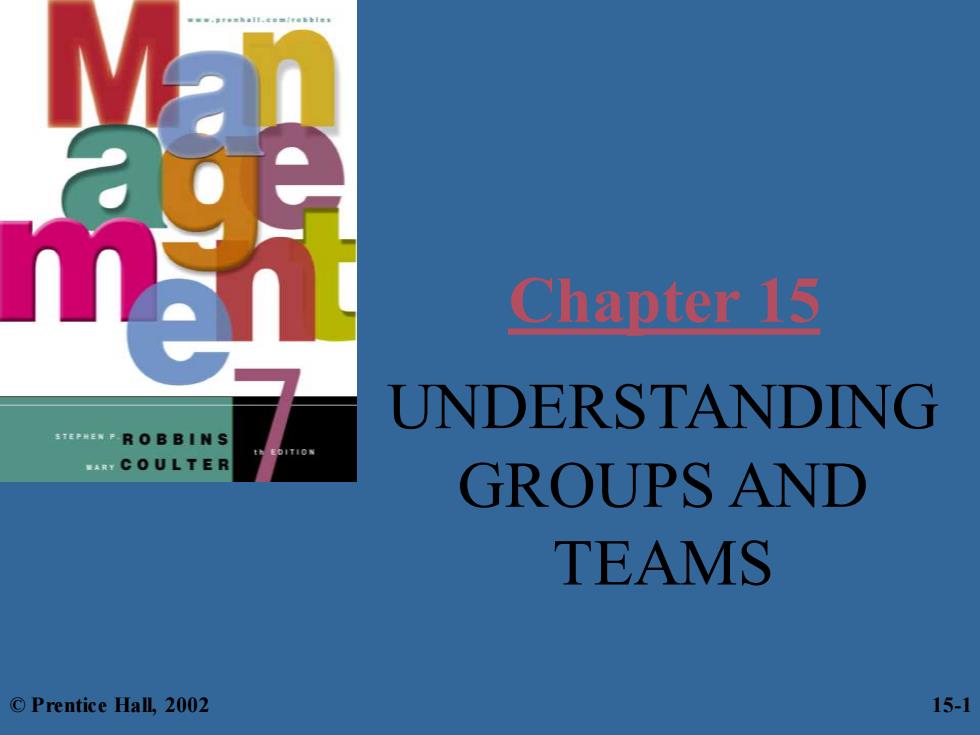
Chapter 15 UNDERSTANDING ROB B I N S COULTER GROUPS AND TEAMS ©Prentice Hall,2002 15-1
Chapter 15 UNDERSTANDING GROUPS AND TEAMS © Prentice Hall, 2002 15-1

Learning Objectives You should learn to: Differentiate between formal and informal groups Describe the five stages of group development -Identify how roles and norms influence an employee's behavior -Describe the key components in the group behavior model Identify the advantages and disadvantages of group decision making ©Prentice Hall,2002 15-2
Learning Objectives You should learn to: – Differentiate between formal and informal groups – Describe the five stages of group development – Identify how roles and norms influence an employee’s behavior – Describe the key components in the group behavior model – Identify the advantages and disadvantages of group decision making © Prentice Hall, 2002 15-2
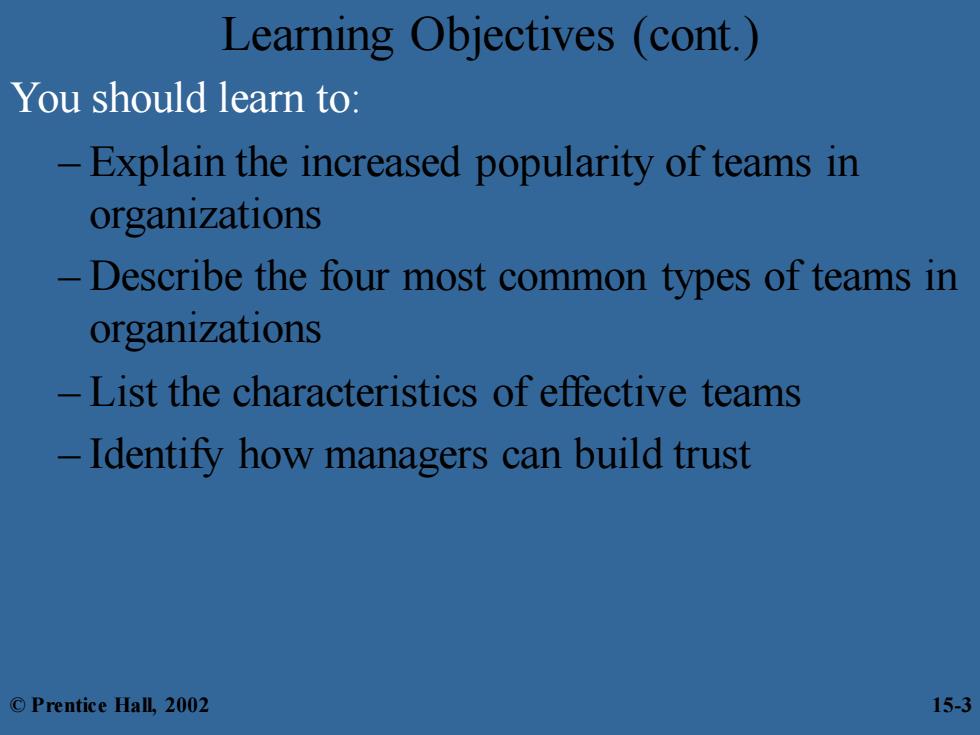
Learning Objectives (cont.) You should learn to: -Explain the increased popularity of teams in organizations -Describe the four most common types of teams in organizations -List the characteristics of effective teams Identify how managers can build trust ©Prentice Hall,2002 15-3
Learning Objectives (cont.) You should learn to: – Explain the increased popularity of teams in organizations – Describe the four most common types of teams in organizations – List the characteristics of effective teams – Identify how managers can build trust © Prentice Hall, 2002 15-3
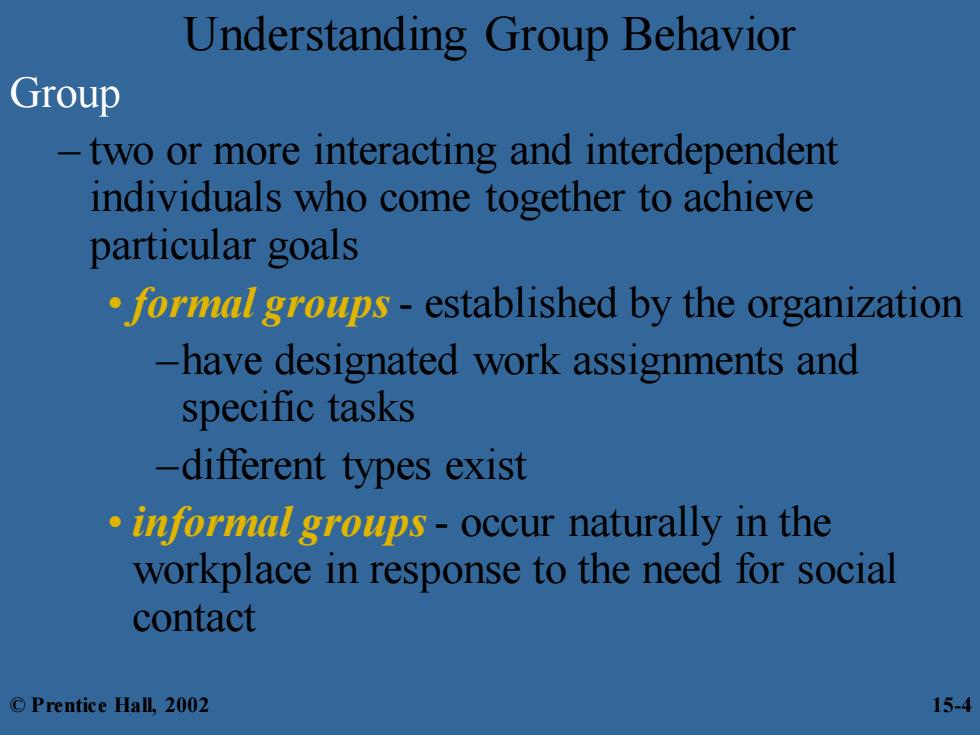
Understanding Group Behavior Group two or more interacting and interdependent individuals who come together to achieve particular goals foragroups-established by the organization -have designated work assignments and specific tasks different types exist informal groups-occur naturally in the workplace in response to the need for social contact ©Prentice Hall,2002 15-4
Understanding Group Behavior Group – two or more interacting and interdependent individuals who come together to achieve particular goals • formal groups - established by the organization –have designated work assignments and specific tasks –different types exist • informal groups- occur naturally in the workplace in response to the need for social contact © Prentice Hall, 2002 15-4
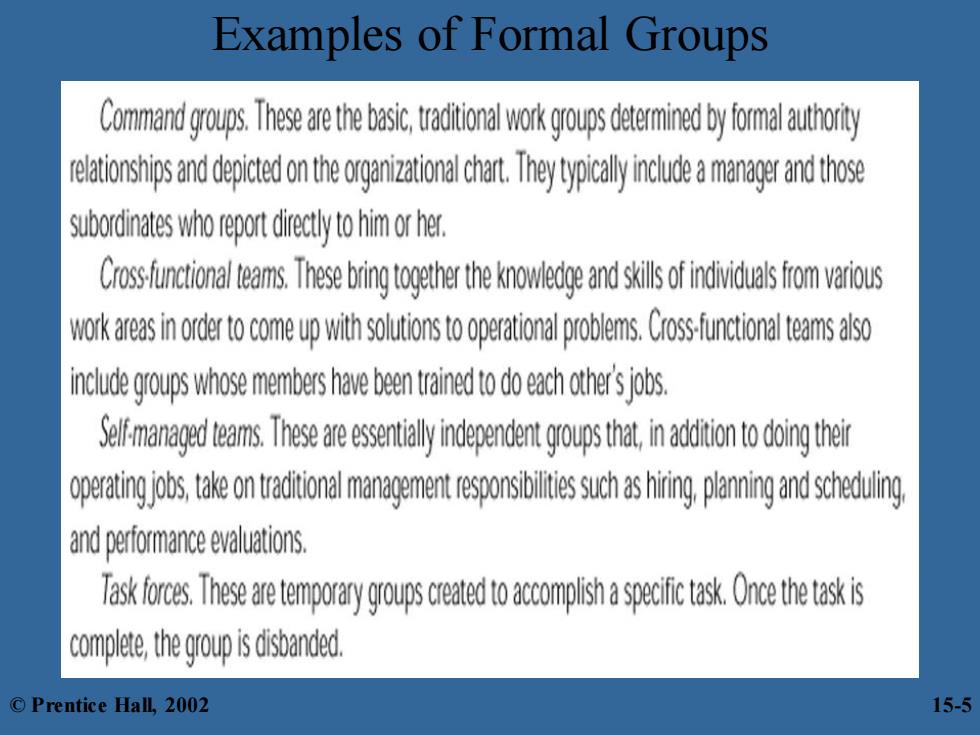
Examples of Formal Groups mmado These re the basic,rar groups determined byfomuthy reltiornshipsanddeoictedontheorgenizationalchat.Theytypicalyincludeamanagrandthose susprtttohimh. m These n tothrth dandsills fnis fromvaious wrkareas inmthirainoblm.fiatmas incudehmmbers have benndchos. S Theseare ssntially independnto that,inthir rain takemanagemniis snai and performance evaluaions. Task forces.These are tmporary goupracomplish aii task.One th task is mle,thisisan ©Prentice Hall,2002 15-5
Examples of Formal Groups © Prentice Hall, 2002 15-5
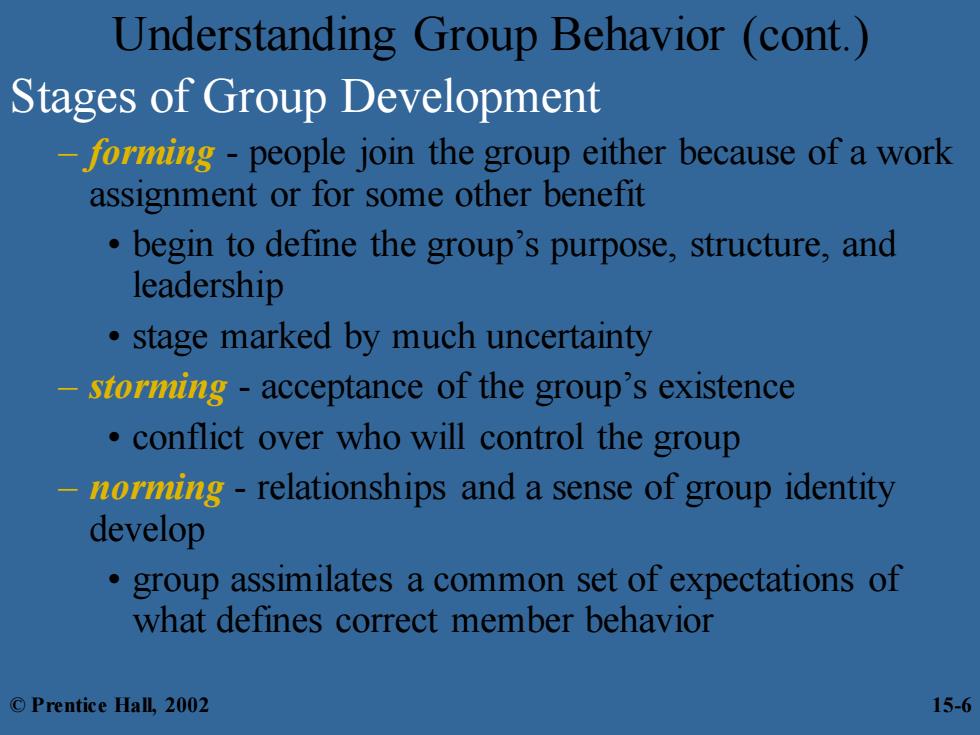
Understanding Group Behavior (cont. Stages of Group Development -oring-people join the group either because of a work assignment or for some other benefit begin to define the group's purpose,structure,and leadership stage marked by much uncertainty -soraing-acceptance of the group's existence conflict over who will control the group -ording-relationships and a sense of group identity develop group assimilates a common set of expectations of what defines correct member behavior ©Prentice Hall,2002 15-6
Understanding Group Behavior (cont.) Stages of Group Development – forming - people join the group either because of a work assignment or for some other benefit • begin to define the group’s purpose, structure, and leadership • stage marked by much uncertainty – storming - acceptance of the group’s existence • conflict over who will control the group – norming - relationships and a sense of group identity develop • group assimilates a common set of expectations of what defines correct member behavior © Prentice Hall, 2002 15-6

Understanding Group Behavior (cont. Stages of Group Development (cont.) -peroring-group structure is functional and accepted group energy has moved to task performance -adfouring-group prepares to disband attention devoted to wrapping up activities group does not necessarily become more effective as it moves through the first four stages group effectiveness is a complex issue that is affected by factors other than developmental stage ©Prentice Hall,2002 15-7
Understanding Group Behavior (cont.) Stages of Group Development (cont.) – performing - group structure is functional and accepted • group energy has moved to task performance – adjourning - group prepares to disband • attention devoted to wrapping up activities – group does not necessarily become more effective as it moves through the first four stages • group effectiveness is a complex issue that is affected by factors other than developmental stage © Prentice Hall, 2002 15-7

Stages Of Group Development Prestage Stage I StageⅡ Forming Storming StageⅢ Stage IV Stage V Norming Performing Adjourning ©Prentice Hall,2002 15-8
Stages Of Group Development Prestage Stage I Forming Stage II Storming Stage III Norming Stage V Adjourning Stage IV Performing © Prentice Hall, 2002 15-8
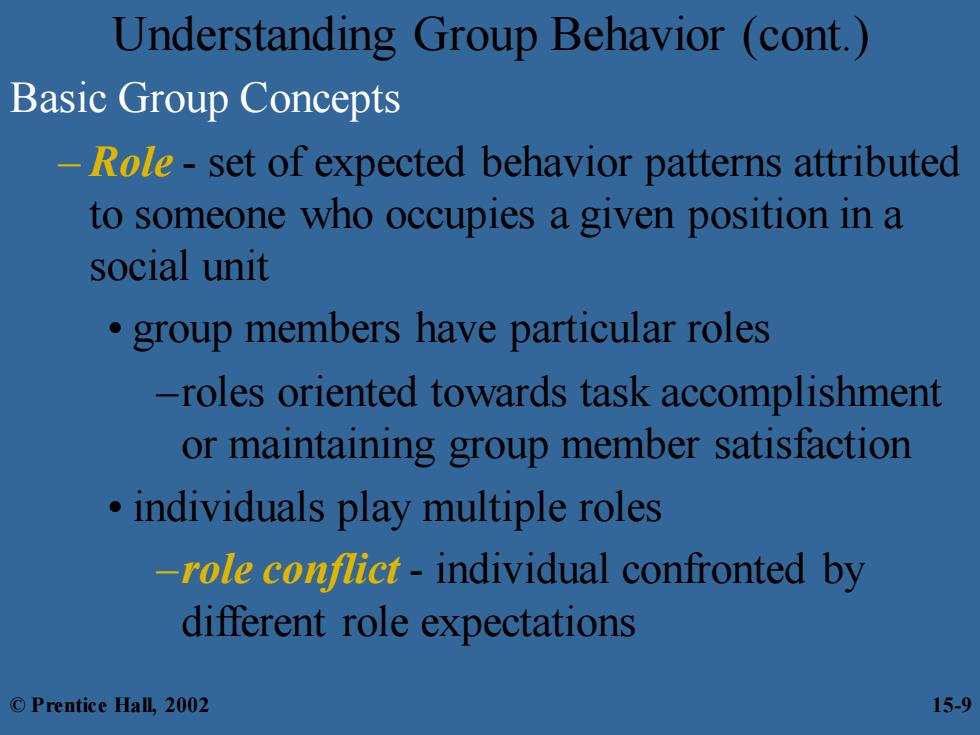
Understanding Group Behavior (cont.) Basic Group Concepts -Rolle-set of expected behavior patterns attributed to someone who occupies a given position in a social unit group members have particular roles -roles oriented towards task accomplishment or maintaining group member satisfaction individuals play multiple roles -rolle conlict-individual confronted by different role expectations ©Prentice Hall,2002 15-9
Understanding Group Behavior (cont.) Basic Group Concepts – Role - set of expected behavior patterns attributed to someone who occupies a given position in a social unit • group members have particular roles –roles oriented towards task accomplishment or maintaining group member satisfaction • individuals play multiple roles –role conflict - individual confronted by different role expectations © Prentice Hall, 2002 15-9
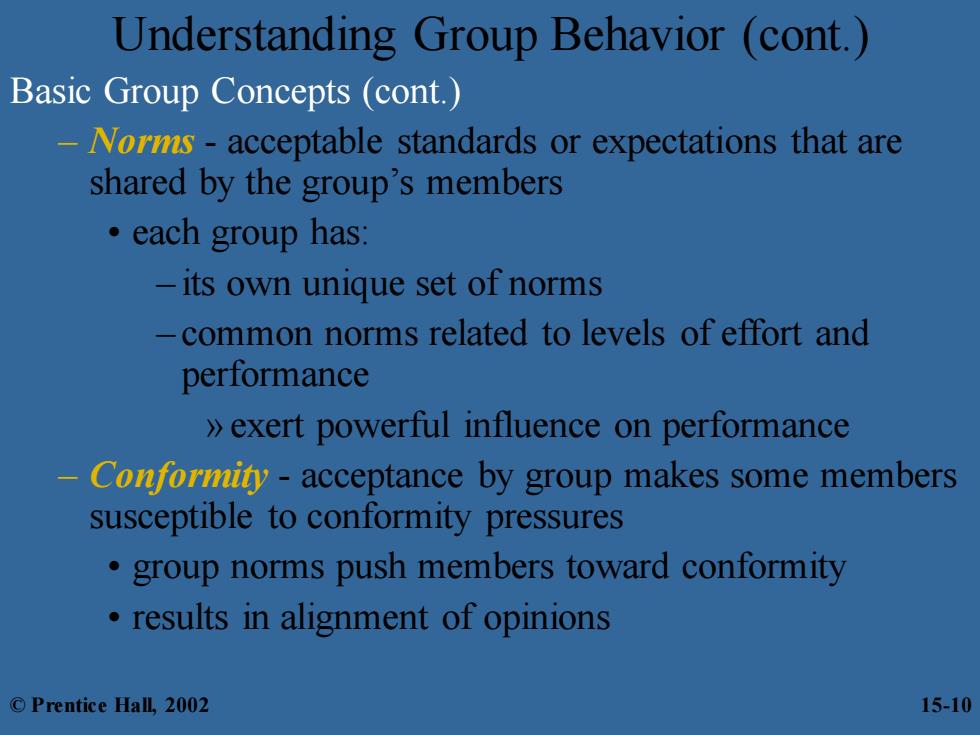
Understanding Group Behavior (cont. Basic Group Concepts (cont.) -Nors-acceptable standards or expectations that are shared by the group's members ·each group has. -its own unique set of norms common norms related to levels of effort and performance >exert powerful influence on performance Coormiiy-acceptance by group makes some members susceptible to conformity pressures group norms push members toward conformity results in alignment of opinions ©Prentice Hall,2002 15-10
Understanding Group Behavior (cont.) Basic Group Concepts (cont.) – Norms - acceptable standards or expectations that are shared by the group’s members • each group has: – its own unique set of norms – common norms related to levels of effort and performance »exert powerful influence on performance – Conformity - acceptance by group makes some members susceptible to conformity pressures • group norms push members toward conformity • results in alignment of opinions © Prentice Hall, 2002 15-10